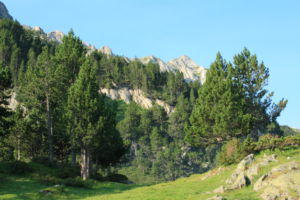The new project wants to conserve, restore and improve the resilience of the mountain pine forests in the Pyrenees, a habitat of priority interest in Europe.
The results of Life UNCINATA* will serve as the basis for the creation of habitat conservation plans and transferable actions at the Pyrenean level.
On February 14, the kick-off meeting of the Life UNCINATA* project was held at the Forest Science and Technology Center of Catalonia (CTFC). The goals of the project are the restoration, conservation, and resilience of mountain pine (Pinus uncinata) forests in calcareous soils in the Pyrenees.
Life UNCINATA* is a project coordinated by the CTFC in collaboration with a consortium made up of CREAF, the Forest Property Center, the Catalonia La Pedrera Foundation, Integra Pirineus, and Gestión Ambiental de Navarra SA. With a budget of €3,736,434, 75% of which comes from the LIFE program of the EU, the consortium has five years to develop demonstrative actions focused on improving biodiversity, mitigating impacts, such as those derived from severe fires or intense herbivory, and the compatibilization of human activities, on mountain pine forests.
During the meeting, the importance of conserving this unique habitat was highlighted, since the characteristics of the calcareous substrate influence the vegetation found, making this type of black pine forest a priority conservation habitat for the EU. “This is a habitat that is only found in the Pyrenees and the Alps, and it is an important element to preserve the biodiversity of ecosystems, as indicated by the EU Habitats Directive. Apart from the interest of the species that conform the habitat, multiple interests of a productive and recreational type come together, and it is essential to avoid the loss of soils,” explains Victor Sazatornil, CTFC researcher and project coordinator.
 With the general objective of restoring, conserving, and making mountain pine forests more resilient, the research team will carry out actions in different protected areas of the Pyrenees such as the Aigüestortes National Park, the Alt Pirineu, Cadí-Moixeró and Ter and Freser Riverhead Natural Parks, the Boumort national hunting reserve, the Larra-Aztaparreta forest reserve in Navarra, and three large private estates, such as the Alinyà mountain, Pedró-Rasos, and El Lago.
With the general objective of restoring, conserving, and making mountain pine forests more resilient, the research team will carry out actions in different protected areas of the Pyrenees such as the Aigüestortes National Park, the Alt Pirineu, Cadí-Moixeró and Ter and Freser Riverhead Natural Parks, the Boumort national hunting reserve, the Larra-Aztaparreta forest reserve in Navarra, and three large private estates, such as the Alinyà mountain, Pedró-Rasos, and El Lago.
Starting from an initial diagnosis of the state of the mountain pine forests on calcareous substrate, the research team will create habitat conservation plans for each of the Special Conservation Zones (ZEC) in which they will work. Among other actions, the project contemplates carrying out improvements in forests that will be left to evolve freely, as well as in forests in which different objectives apart from conservation coexist. Depending on the location and the previously identified problems, grazing of domestic cattle will be redirected, as well as wild herbivores in certain points, actions will also be carried out to regulate the excess of human frequentation, and the vulnerability of some forests to forest fires will be reduced. “The introduction of new multifunctional forest management models can contribute to mitigating the problems faced by this habitat,” says Pol Guardis, CTFC researcher. In addition, like other LIFE program projects, a series of actions aimed at enhancing the value of the habitat and the actions that will be carried out are contemplated.
The team hopes that the conservation and restoration actions developed by Life UNCINATA* will serve as a model and be transferable to the rest of the Pinus uncinata forests in Europe that suffer, or may suffer soon enough, the same conservation problems as the forests in which the project will work. “We hope the results will help us to create new conservation plans and actions that can be transferred to the whole habitat on a European scale,” says Sazatornil. Thus, the project wants to contribute to the development and management of the Natura 2000 network, and the achievement of the objectives of the 2030 European Strategy for Biodiversity.
Last modified: 31 May 2024










